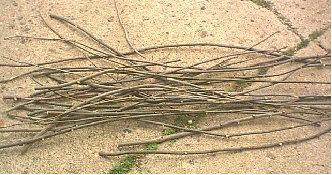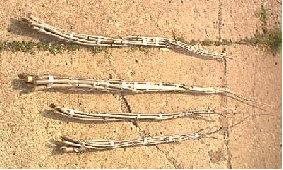Bundling Shafts
Stealing a trick from the Arrow-Makers
Daryl Hrdlicka
Jeffers Petroglyphs Historic Site
August 5, 2002
When it comes to making dart shafts out of natural wood (saplings, shoots, or branches), one of the first things you'll discover is that trees do not grow in nice, straight lines. It's fairly easy to find a piece that's long enough and the right diameter, but it will need to be straightened.
If you're working on several shafts at a time and they're still flexible, there's something you can do to make the job easier. It's called bundling, which means lashing a bunch of shafts together to let them pull each other into line.
This will also give them time to dry out a little. If they're too green, they'll be too flexible for you to straighten well. If you try, the shafts will simply return to their original shape when you're done.
As a rule, you shouldn't cut more shafts than you'll use at one time, but recently I found an ash tree near my home that had blown down in a storm. Several branches were still flexible, so I decided to bundle them together to work on later.

The Raw Shafts
I ended up with 24 shafts from about 48" to 72". Most were pretty good, but there were a few that were very crooked. I separated them into two piles -- close to straight, and everything else.
For the ones that were close to straight, I just picked out 6 or 7 and laid them down, making sure the ends were lined up. Since the bark was still on, I used filament tape and strapped them together at the bottom as tightly as I could. I moved up the shaft about 6" or so and taped them again, pulling the shafts tightly together, and kept working my way up the bundle to the tips.

Bundle in Progress
For shafts that are badly curved or very thick, you'll need help. Since thicker shafts will bend smaller shafts, and since a bad curve will just warp the other shafts around it, I bundle them around something hard and straight like a broom handle. This gives me a very secure central column which forces the shafts to straighten to match. You can do this with the other shafts too, but I don't have that many spare handles lying around. I save them for the troublemakers.

"Broom" Bundle
After all the bundles are finished, you can let them sit until you have time to start working them. They'll keep this way for up to 3 weeks, but the sooner you get to them the better. Drier shafts will crack much easier during the straightening process.

Finished Bundles
So here are the finished bundles, each with 6 shafts in them and one wrapped around a broom handle. Are they perfectly straight? No. But they will be a lot straighter when I take them out of the bundles than they were before I put them in. Even if I've only saved myself 5 minutes straightening time per shaft, that's going to end up saving me two hours total for all of them.
Tips
- As a rule, don't bundle more than 7 shafts together at one time. More than that and it's just too hard to work with, and possibly less effective.
- When making a bundle, use shafts that are about the same length. That way you don't end up with one long one with no support for the end.
- If a shaft has a strong curve to it, place it in the bundle with the curve bending away from the center. When you tape it down, pull it back into line.
- If all of the shafts are fairly straight, you only need to tape them every 12" or so. But if there are a lot of bends, you will need to strap them closer together, maybe every 4".
- If the bark is still on, you can use filament (strapping) tape to hold the bundle together. It holds better than string, and any gummy residue will come off with the bark. For bare shafts, though, you should use string or twine.
- You can use bundling if you only have one shaft to straighten out. I had a green willow shaft that was too flexible to work on, so I peeled the bark off and strapped it to a finished shaft and let it sit. Two days later I untied it, and it had dried beautifully. I think it only took 3 minutes to finish straightening it.
- To help shafts straighten out while bundles, you need heat and humidity. I found a lazy way to do this. After the bundles are finished, I put them in the back of my car for a while and forget about them. The heat that accumulates during the day will soften up the wood, and the bends will straighten out a lot faster.
This also works against you, though. You should never leave your finished shafts (or finished darts, for that matter) in your car for long periods of time. They will soften and bend to match whatever you have them lying on, which means you'll have to straighten them again later.
Dart Construction |
Home




